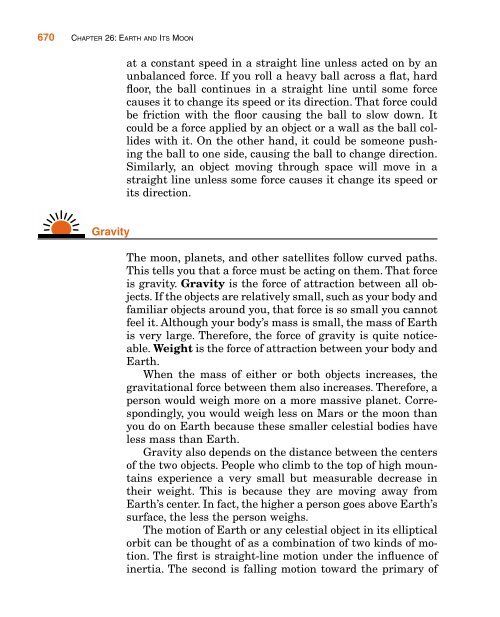Chapter 26 Earth and Its Moon
Chapter 26 Earth and Its Moon
Chapter 26 Earth and Its Moon
You also want an ePaper? Increase the reach of your titles
YUMPU automatically turns print PDFs into web optimized ePapers that Google loves.
670 CHAPTER <strong>26</strong>: EARTH AND ITS MOON<br />
Gravity<br />
at a constant speed in a straight line unless acted on by an<br />
unbalanced force. If you roll a heavy ball across a flat, hard<br />
floor, the ball continues in a straight line until some force<br />
causes it to change its speed or its direction. That force could<br />
be friction with the floor causing the ball to slow down. It<br />
could be a force applied by an object or a wall as the ball collides<br />
with it. On the other h<strong>and</strong>, it could be someone pushing<br />
the ball to one side, causing the ball to change direction.<br />
Similarly, an object moving through space will move in a<br />
straight line unless some force causes it change its speed or<br />
its direction.<br />
The moon, planets, <strong>and</strong> other satellites follow curved paths.<br />
This tells you that a force must be acting on them. That force<br />
is gravity. Gravity is the force of attraction between all objects.<br />
If the objects are relatively small, such as your body <strong>and</strong><br />
familiar objects around you, that force is so small you cannot<br />
feel it. Although your body’s mass is small, the mass of <strong>Earth</strong><br />
is very large. Therefore, the force of gravity is quite noticeable.<br />
Weight is the force of attraction between your body <strong>and</strong><br />
<strong>Earth</strong>.<br />
When the mass of either or both objects increases, the<br />
gravitational force between them also increases. Therefore, a<br />
person would weigh more on a more massive planet. Correspondingly,<br />
you would weigh less on Mars or the moon than<br />
you do on <strong>Earth</strong> because these smaller celestial bodies have<br />
less mass than <strong>Earth</strong>.<br />
Gravity also depends on the distance between the centers<br />
of the two objects. People who climb to the top of high mountains<br />
experience a very small but measurable decrease in<br />
their weight. This is because they are moving away from<br />
<strong>Earth</strong>’s center. In fact, the higher a person goes above <strong>Earth</strong>’s<br />
surface, the less the person weighs.<br />
The motion of <strong>Earth</strong> or any celestial object in its elliptical<br />
orbit can be thought of as a combination of two kinds of motion.<br />
The first is straight-line motion under the influence of<br />
inertia. The second is falling motion toward the primary of

















